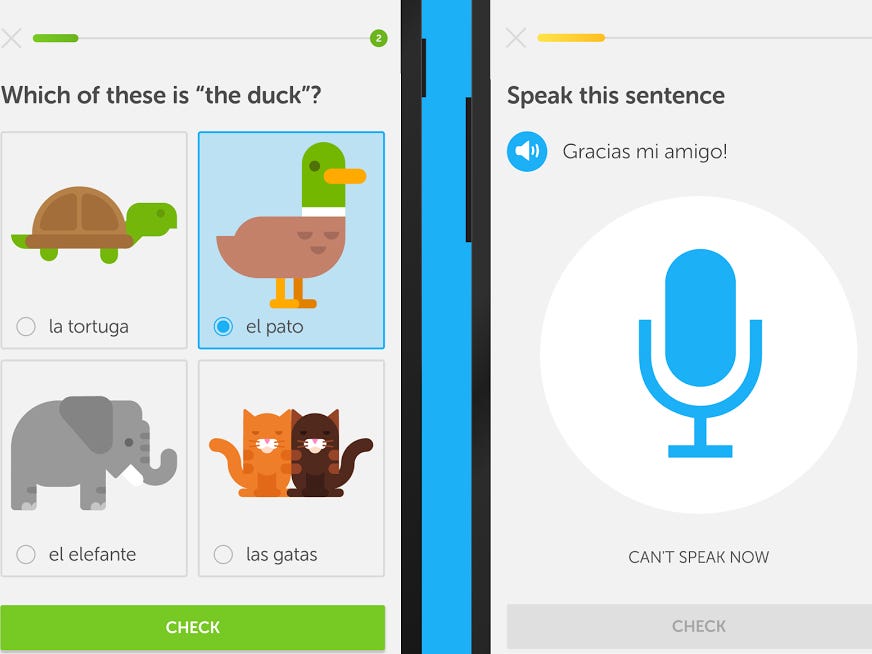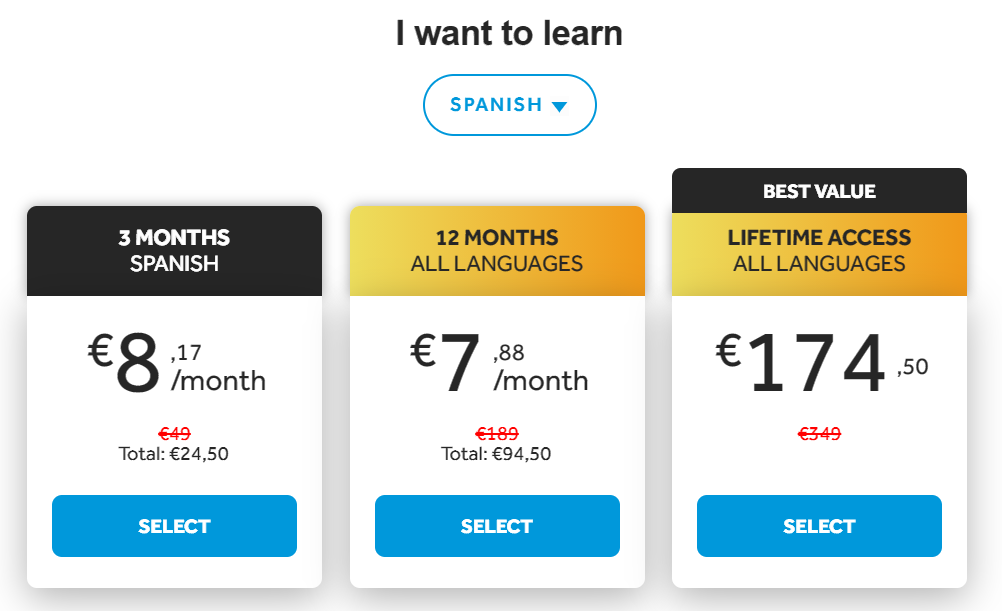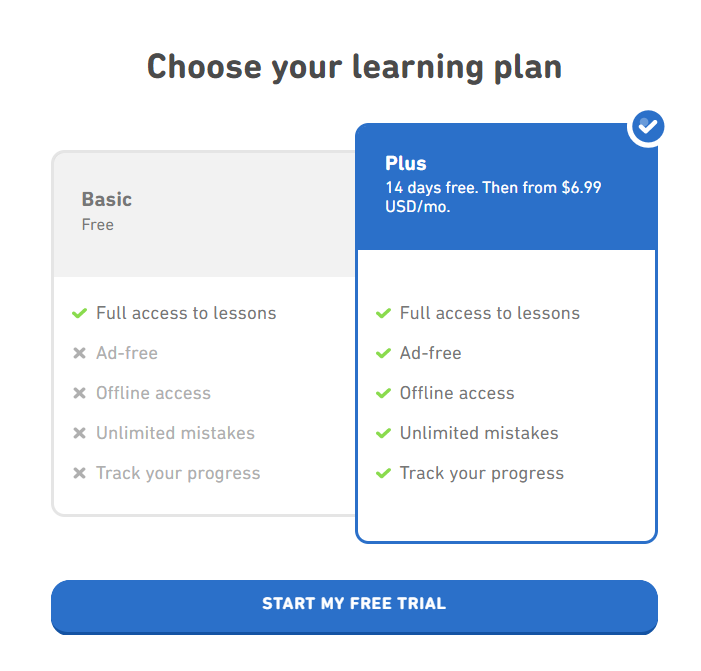In this Rosetta Stone vs Duolingo review you will find out will that the good old Rosette will cede its throne to the newer Duolingo. Let’s see which language learning platform will take the win here.
If you are a language learning lover or just looking for a platform that will help you in that department, there are serious chances that you already heard of Rosetta Stone and Duolingo. Both of them are pretty good and many people don’t know which one to choose. I hope this Rosetta Stone Vs Duolingo Review will help make the decision your language “teacher”. I will share with you how these apps work, the main features, their prices, and alternatives to consider as well.
Rosetta Stone Vs Duolingo: Languages Available
Both apps offer those languages to their users:
|
Arabic |
Italian |
|
Chinese (Mandarin) |
Japanese |
|
Dutch |
Korean |
|
English (British and American) |
Portuguese (Brazil) |
|
French |
Polish |
|
German |
Russian |
|
Greek |
Spanish (Latin America and Spain) |
|
Hebrew |
Swedish |
|
Hindi |
Turkish |
|
Irish |
Rosseta attention is that the mobile version is limited to 24 languages. Besides mentioned above, you can learn:
|
Filipino |
|
Persian (Farsi), |
|
Vietnamese |
These are the languages that you can find using Rosseta but can learn on Duolingo:
|
Czech |
Klingon |
|
Danish |
Navajo |
|
Esperanto |
Norwegian |
|
Finish |
Romanian |
|
Hawaiian |
Scottish Gaelic |
|
Hungarian |
Swahili |
|
High Valyrian |
Ukrainian |
|
Indonesian |
Welsh |
Rosetta Stone Vs Duolingo: The Similarities
Both options are meant to offer language courses for casual learners that have little time to study. Rosetta Stone and Duolingo both include options for more in-depth study, but the core software will leave you with language proficiency you can build on to get through the occasional holiday. In other words, it’s highly unlikely that you will become fluent in any language since we can’t really expect from around 20 days worth of content to teach us to the level equivalent to college-degree language courses.
How to use them
The most important feature that both platforms have is easy use. You can begin learning a second you sign up or installing the necessary components. If you want to use Duolingo, you just need to register an account using your email address and download the Android or ios app to study remotely. As for Rosetta Stone, you need to install from a CD-ROM/download code or access through an online subscription service.
How lessons look like
Rosetta Stone and Duolingo both nurture lessons that are short enough to be easily incorporated into users’ daily life. They offer different overarching topics which are distributed into several small lessons. So, you will not have to invest more than ten minutes per lesson – time for repetitions of content now and then are not included in this count. In other words, it will take you about a week to finish a topic. Or about twenty minutes per day if you add reviews and repetitions to your routine.
As for your reading skills, they will probably improve pretty fast with both platforms since you are constantly looking at the text. On the other side, listening can be a two-sided blade because the audio samples often sound unnatural and robotic.
Both Rosetta Stone and Duolingo assume you are a beginner in learning the language you want to speak. So, they start off with the absolute basics – words like man, woman, boy, girl, foods, introductions, and greetings…
Rosetta Stone Vs Duolingo: What’s different
As I mentioned before, both platforms have some big similarities, but the devil is (as always) in the details.
Rosetta’s method is more formal and traditional compared to Duolingo’s. The lessons are primarily auditory with images. However, if you cant listen to audio or repeat the phrases, you can just switch the “reading and writing only” option in Speech Settings and Lesson Settings. The lesson structure revolves around grammar, pronunciation, and vocabulary.

If you look into a typical lesson, the app displays 4 pics and a word. You just need to choose a photo that matches the word. It can be a bit tricky if you’re totally new to the language you are studying. So, there’s no option to tap the word and see its translation like in Duolingo. And in case you’re not sure what the app wants you to do, you can just tap the lightbulb at the bottom of the screen for more instructions. However, some question sections will show you a translation if you long-press on the photo. Having all of that in mind, Rosetta Stone is less intuitive than Duolingo, especially if the sound is off.
Unlike Rosetta Stone, Duolingo is known for its’ simple, colorful interface and short, game-like exercises. It doesn’t restrict how many languages you can study at the same time and you can complete as many lessons as you want in one day even on – even on the free version.

Rosetta Stone Vs Duolingo: Pros and Cons
Rosetta Stone
| Pros | Cons |
| Easy to use | High price |
| Thoroughly tested and refined by experts | The method makes it difficult to study grammar |
| Many features | Content needs to be more compelling |
| Great for beginners who need a slow pace | Some features are still buggy |
| Many languages to choose from |
Duolingo
| Pros | Cons |
| Easy to use | Core content needs to be more compelling |
| Completely free | Core program could use more features |
| Great for beginners who need a slow pace | |
| Interesting experimental/community features | |
| Many languages to choose from |
Rosetta Stone Vs Duolingo: Price
Rosetta Stone has a variety of subscription options: A 3-month subscription runs $28,50 (€24,50), a 12-month subscription is $111.50 (€94,50), and a lifetime access for $207 (174,50).

Pay attention to the fine print if you don’t want to subscribe to a plan though, as the option to continue on a free version is pretty easy to miss. You can stick with the free version, but you’ll only be able to take lessons on the app, not a PC. The app also limits the number of lessons you can complete each day on the free version.
Duolingo is completely free and can be used either on your desktop computer or via the official ioS and Android apps. If you want to disable the in-app ads or download lessons for offline use, you can purchase a so-called Duolingo Plus subscription for $6.99 per month, but none of Duolingo’s content is hidden behind a paywall.

Final Thoughts
If you ask me, I would rather use Duolingo since it’s easy to use, has quick lessons and extra learning tools. However, Rosetta Stone is good for diving head-first into a language and challenging yourself by only working in that new language. Honestly, the best option for you is to try them both for free and see which better matches your learning style.
Also, you can try Ling App if you want to learn a new language in an interesting and fun way. Read Ling App review to know what people are saying about the app.



















